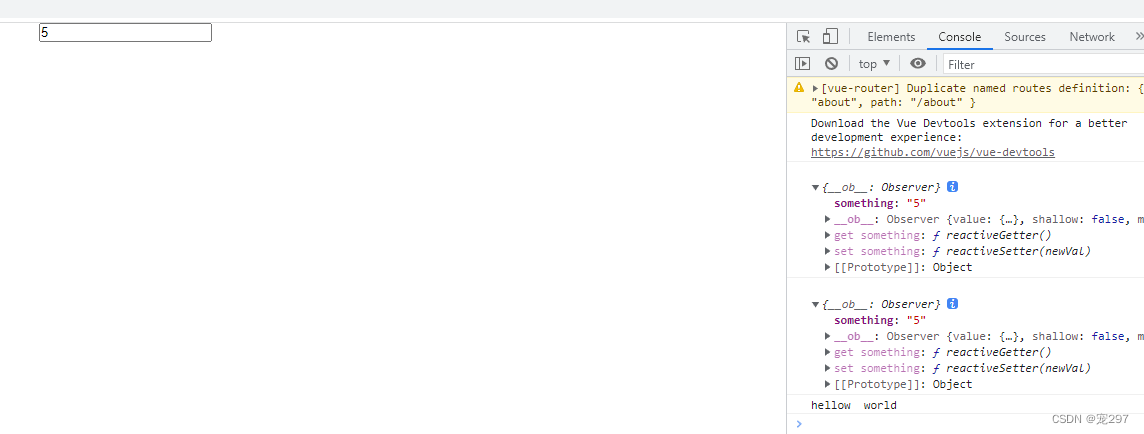watch:是vue中常用的侦听器(监听器),用来监听数据的变化
watch: {
这里写你在data中定义的变量名或别处方法名: {
handler(数据改变后新的值, 数据改变之前旧的值) {
这里写你拿到变化值后的逻辑
}
}
}
|
1
2
3
4
5
6
7
8
9
10
11
12
13
14
15
16
17
18
19
20
21
22
23
24
25
26
27
28
29
30
31
32
33
34
|
<template> <div> <div> <input type="text" v-model="something"> </div> </div></template><script> export default { name: "AboutView", components: {}, data() { return { something: "" } }, watch: { //方法1 "something"(newVal, oldVal) { console.log(`新值:${newVal}`); console.log(`旧值:${oldVal}`); console.log("hellow world"); } //方法2 "something": { handler(newVal, oldVal) { console.log(`新的值: ${newVal}`); console.log(`旧的值: ${oldVal}`); console.log("hellow world"); } } } }</script> |
在输入框中输入1、4 效果图如下:

|
1
2
3
4
5
6
7
8
9
10
11
12
13
14
15
16
17
18
19
20
21
22
23
24
25
26
27
28
29
|
<template> <div> <div> <input type="text" v-model="obj.something"> </div> </div></template><script> export default { name: "AboutView", components: {}, data() { return { obj: { something: "" } } }, watch: { "obj.something": { handler(newVal, oldVal) { console.log(`新的值: ${newVal}`); console.log(`旧的值: ${oldVal}`); console.log("hellow world"); } } } }</script> |
在输入框中输入4、5 效果图如下:

1、作用:immediate页面进来就会立即执行,值需要设为true
2、用法如下方代码所示:
|
1
2
3
4
5
6
7
8
9
10
11
12
13
14
15
16
17
18
19
20
21
22
23
24
25
26
27
28
29
30
|
<template> <div> <div> <input type="text" v-model="obj.something"> </div> </div></template><script> export default { name: "AboutView", components: {}, data() { return { obj: { something: "" } } }, watch: { "obj.something": { handler(newVal, oldVal) { console.log(`新的值: ${newVal}`); console.log(`旧的值: ${oldVal}`); console.log("hellow world"); }, immediate:true } } }</script> |
进来页面后立即加载,效果图如下:

1、作用:deep 用来监听data中的对象,值需要设为true
2、用法如下方代码所示:
|
1
2
3
4
5
6
7
8
9
10
11
12
13
14
15
16
17
18
19
20
21
22
23
24
25
26
27
28
29
30
|
<template> <div> <div> <input type="text" v-model="obj.something"> </div> </div></template><script> export default { name: "AboutView", components: {}, data() { return { obj: { something: "" } } }, watch: { "obj": { handler(newVal, oldVal) { console.log(`新的值: ${newVal}`); console.log(`旧的值: ${oldVal}`); console.log("hellow world"); }, deep:true } } }</script> |
注意:
1、console.log(`新的值: ${newVal}`); 这种打印出来的是对象的类型,如下图:

2、console.log(newVal);这种打印出来的是对象本身,如下图:

到此这篇关于VUE中watch的详细使用教程的文章就介绍到这了,更多相关VUE watch使用教程内容请搜索以前的文章或继续浏览下面的相关文章希望大家以后多多支持!
